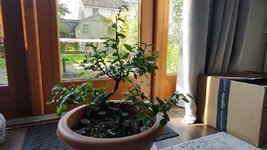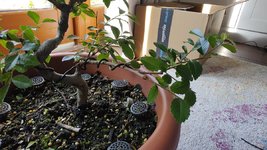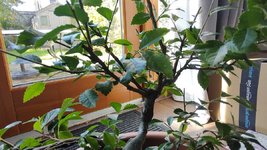vcnsiqueira
Sapling
Hey guys!
I've been developing some Chinese elms that I bought in a nursery on March this year. Three elms in a single pot.
I repot them and I've be growing through the year. All of them have a vigorous growth and during this growing season I pruned them 2 times.
Last weekend I did the last pruning and decided to wire some of the branches (first and second branches) to position in kind of a horizontal way.
Well, I don't know if I wired very tight or the tree grows ridiculously fast (not complaining) but today (after only 6 days) I realised the wire was biting the branch. I'm very beginner so I imagine the wire was really too tight. I remove the wire and wired again in a very loose way to prevent the biting (if you can give me any advice I would appreciate - maybe not the right moment to wire).
I don't think this tree will be amazing at all, but I kinda like it and the original idea to buy it was to learn the most I could with a initial tree instead of handling too young seedlings or saplings.
Anyway, besides the wiring situation, one thing is bothering me a lot. The apex of the tree. This tree had been chopped and from the apex there are 4 different branches and now that I've been looking at it, ifI leave them all, I will probably have an inverse taper on the tree. It seems a big "ball" is going to grow on the top, making the tree very ugly. At the same time, the way it is, it seems the tree has already a good harmony on the top of the tree. I mean, if I cut some of the branches I will have to grow the top of the tree from zero and it will have a lot of empty spaces to be filled up later.
Could you give me ideas of what to do? And please could you criticise what I've done so I can learn from my mistakes?




I've been developing some Chinese elms that I bought in a nursery on March this year. Three elms in a single pot.
I repot them and I've be growing through the year. All of them have a vigorous growth and during this growing season I pruned them 2 times.
Last weekend I did the last pruning and decided to wire some of the branches (first and second branches) to position in kind of a horizontal way.
Well, I don't know if I wired very tight or the tree grows ridiculously fast (not complaining) but today (after only 6 days) I realised the wire was biting the branch. I'm very beginner so I imagine the wire was really too tight. I remove the wire and wired again in a very loose way to prevent the biting (if you can give me any advice I would appreciate - maybe not the right moment to wire).
I don't think this tree will be amazing at all, but I kinda like it and the original idea to buy it was to learn the most I could with a initial tree instead of handling too young seedlings or saplings.
Anyway, besides the wiring situation, one thing is bothering me a lot. The apex of the tree. This tree had been chopped and from the apex there are 4 different branches and now that I've been looking at it, ifI leave them all, I will probably have an inverse taper on the tree. It seems a big "ball" is going to grow on the top, making the tree very ugly. At the same time, the way it is, it seems the tree has already a good harmony on the top of the tree. I mean, if I cut some of the branches I will have to grow the top of the tree from zero and it will have a lot of empty spaces to be filled up later.
Could you give me ideas of what to do? And please could you criticise what I've done so I can learn from my mistakes?




